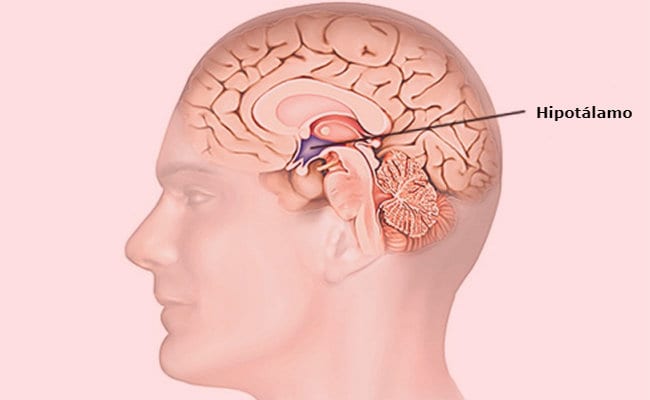It is the most important area of the brain since it is responsible for controlling the hormones released into the body through the pituitary gland, it is also responsible for the imagination and learning produced by the brain.
Definition and functions
The hypothalamus is responsible for organizing the behaviors of the individual, the change in body temperature, and also regulates aggression, reproduction and intake. It is the rnuclear region located in the lower part of the thalamus and it is made up of a large part of the diencephalon.

What are the functions of the hypothalamus?
The hypothalamus fulfills many functions of the body such as the intake of food, whether liquid or solid, mating, all emotions, aggressions, among others, these behaviors can be divided into two types, those that are clearly visceral and those that are emotional.
Hunger
It is capable of regulating all feelings triggered by hunger, and even those that exist after eating, such as satiety, in turn is characterized by controlling levels of cholesterol, glucose, triglycerides, among others.
Dream
The circadian rhythm better known as wakefulness and sleep are controlled by the posterior and anterior parts of the hypothalamus, which have the ability to regulate and control them, so that the body can have a good rest, which generates a good source of energy. for the next day and the good performance of the body.
Emotions
The emotions that the human being feels are produced by a set of chemical substances which have their meeting point in the hypothalamus gland, which are called as neuropeptides or neurohormones that are the result of the union of other substances known as amino acids and peptides, due to this it has come to be considered that emotions such as anger, sadness, joy, sexual appetite arise in the hypothalamus, feeling of being in love, among others.
The hypothalamus exerts a control, and in turn regulates the autonomic system, through the influence that it has on the brain stem, for which it is considered as the region responsible for the common physiological expression, communication is achieved through the union of several systems that are comprised in this way, the medial forebrain bundle, which joins the trunk with the hypothalamus in two directions, and in the rostral direction, joins the septal region with the hypothalamus as well as with areas of the prefrontal cortex.
Temperature
There are two types of hypothalamus, the rostral or anterior, medically known as the parasympathetic, and the caudal or posterior, which in medical terms is known as sympathetic, which are given different activities related to temperature, being the parasympathetic the one that diffuses or dissipates. the heat, while the nice guy takes care of regulate body temperature so that it remains constant and stable, relying on the control of the frequency of sweating and respiratory rate.
Neuroanatomy
The hypothalamus is characterized by being a completely nuclear region, which is why it is comprised of the composition of several nuclei that have gray matter, which have certain limits, among which the following can be mentioned.
- Lower limit: floor that is the lowest limit of this composed of several parts, among which are the mammillary tubercles, the optic chiasm, the optic strips and the pituitary stalk.
- Lateral limit: this is comprised between the internal capsules.
- Front limit: the supra-optic lamina, which is better known as the terminal lamina
- Rear limit: it is in the trigone, which in a more specific way, is in a frontal plane than behind the mammillary tubercles.
Cell types in the hypothalamus
In the hypothalamus, two types of neurons that have the ability to secrete can be identified, which will be described below.
- Magnocellular neurons: They are considered as an extension of the hypothalamus, they are known as the majority cells, because of the two types, they are the ones that have a greater size. These have the ability to produce hormones of a peptic nature, which are known as the neuro-pituitary, this is the nervous part of the pituitary, in which blood is poured and stored and poured.
- Parvocellular neurons: are characterized by having the ability to release hypophysotropic factors better known as peptide hormones located in the primary plexus of the median eminence, where the stimulation of other pituitary hormones occurs, those responsible for this are the adenohypophysis hormones, among these hormones the most common are gonadotropin, prolactin, and thyrotropin-releasing hormones in addition to growth-promoting hormones.
These types of neurons also have the ability to generate two types of somatic nuclei, which are paraventricular and supraoptic.
Neural nuclei
Apart from the two nuclei that were mentioned in the previous category, there are other types of these, among which the most important are the following.
- Dorso-medial nucleus.
- Ventro-medial nucleus.
- Mamillary nucleus.
- Preoptic nucleus.
- Suprachiasmatic nucleus.
- Infundibular nucleus.
- Lateral nuclei.
- Anterior hypothalamic nucleus.
- Posterior hypothalamic nucleus.
Each of these has different characteristics, which perform vital functions in the body, such as temperature regulations such as cold or heat, satiety, the release of hormones and substances, as well as sympathetic and parasympathetic functions, including participation in memorization and sweating processes, and feelings of hunger, fear, anger and all known emotions.
Hormones generated
This endocrine organ has many functions that are very positive for the human body, such as the release of inhibitory and stimulating factors in the blood to maintain a good flow of this vital fluid, as well as the control of its temperature, although it also has other qualities. such as the creation of new neurohormones destined to be secreted in the body, such as oxytocin and antidiuretic hormone.
Hello, excuse me, could you send me your last name? It's for a job porfiiis 🙁